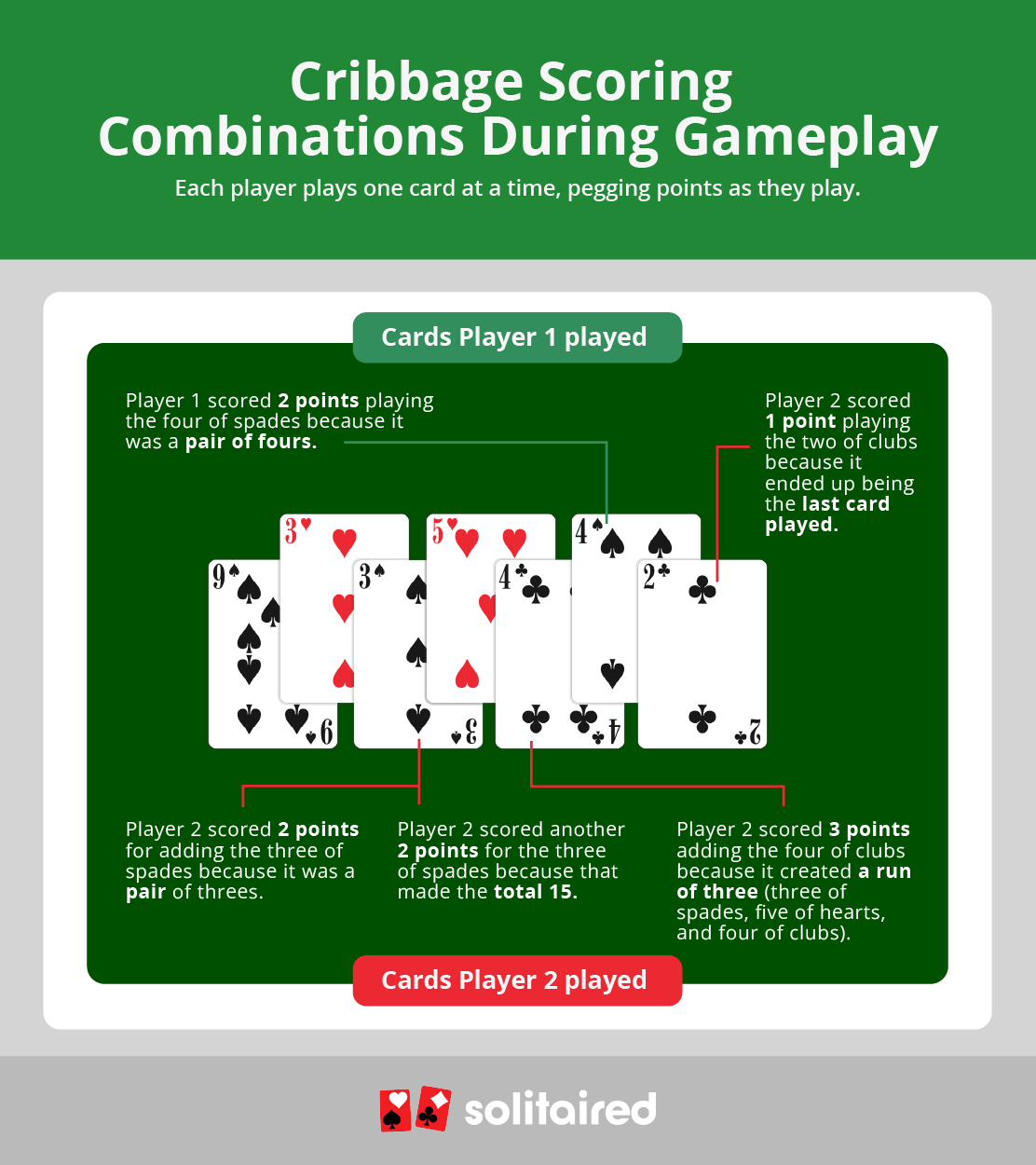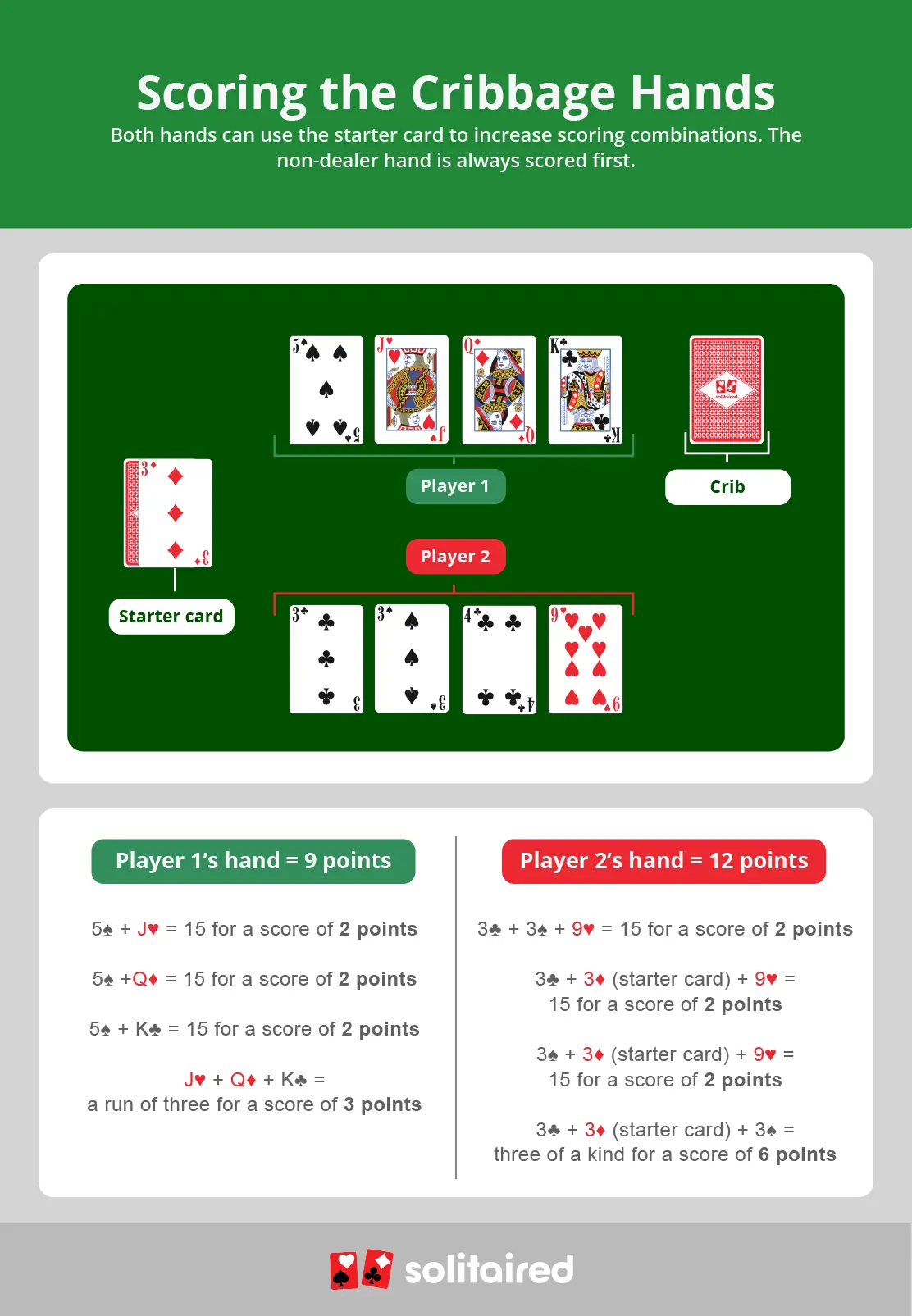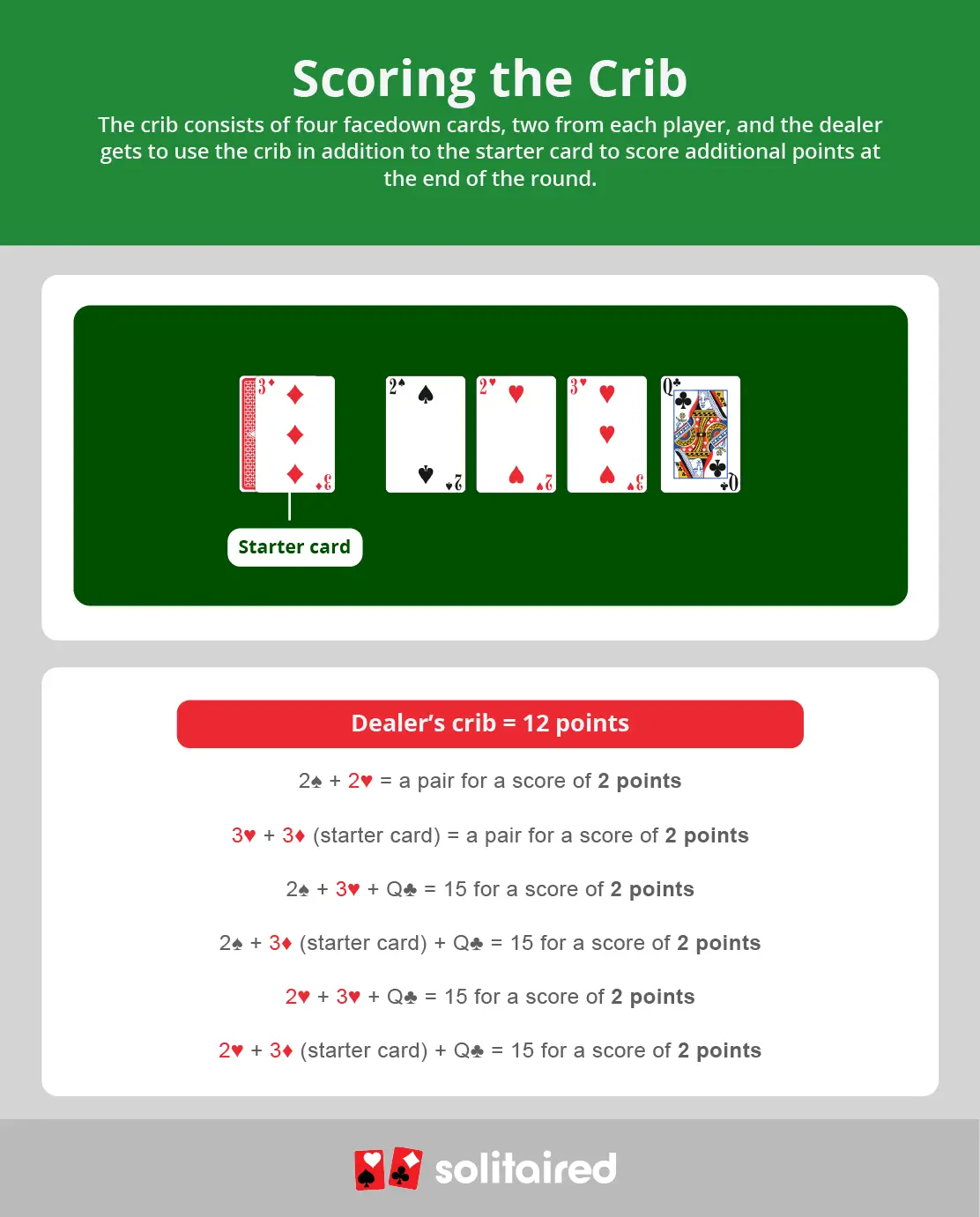Cribbage Scoring: How to Peg Points and Strategize with Scoring
By Neal Taparia - 05/02/2025
Cribbage is a fun 2-player card game where you win if you’re the first player to score 121 points. You score points by creating different card combinations during three parts of the game: while you play, when you score your hand, and when you score the crib.
Cribbage rules aren’t difficult; in fact, because the game has few rules, it’s easy to learn to play, but if you want to win, you need to know which card combinations score the most points.
You keep score on a special board, moving pegs as you score points, but even if you don’t have a cribbage board, you can tally scores or just play Cribbage online with Solitaired.
Cribbage Quick Start Gameplay Rules
The rules of Cribbage are few and easy to follow. The game follows three distinct phases outlined below, all focused on scoring points.
Building the Crib
Once you decide who deals first, that player shuffles and deals out six playing cards to each player. Players then must place two cards facedown into the crib—they must choose these two cards from the six they were dealt, leaving them with four cards each. The crib will be a bonus hand that the dealer scores, and players will alternate deals so they take turns scoring the crib.
After the crib is built, the dealer then turns over the top card from the deck to be the starter card. This card won’t be used until scoring the hands and crib.
Pegging Play
The non-dealer starts this phase by placing one card in the middle and saying the total. If they played a four, they would say, “Four.” The other player places a card overlapping their opponent’s card and then says the new total.
All cards follow their rank, but face cards are 10. So if the second player played a queen, they would call out, “Fourteen.” If the combination of cards results in a scoring combination, the player who played the last card can peg those points. For example, if the next player plays an ace, they would say, “Fifteen,” and peg two points for making 15.
Continue playing until the total reaches 31 or as close to it as possible without going over. If you haven’t reached 31, but you can’t play without going over, then you say, “Go.” Then your opponent gets a chance to play. If they can’t play without going over, they say, “Go.” Then the person who played the last card pegs a point, and players gather back the cards they played. If the last play makes exactly 31, that player gets to peg 2 points.
If any player has cards left in their hand, the players begin playing cards to the middle again. The player who didn’t play the last card goes first. Play continues until all players’ cards are gone.

Scoring Hands and the Crib
After the hand has been played, players score their hands and the dealer scores the crib. The starter card gives each player a fifth card to use when scoring their hands and the crib. The non-dealer scores their hand first, according to the card combinations they can make with their hand and the starter card. Then the dealer scores their hand as well as the crib.
As soon as a player reaches 121 points, even if it’s in the middle of pegging play, they win, and the game is over.
Rules for Scoring Cribbage
Understanding which combinations help you score the most points help you strategize effectively. Part of what makes Cribbage such an easy card game is that you don’t have to memorize scoring combinations and point values. Just keep this Cribbage scoring chart with you as you play to use as a quick reference. No matter what phase you’re scoring, the ace is never high. So consider the ace to be one; it always precedes a two but never follows a king.
| Card Combination/Play | Points Scored | Example |
|---|---|---|
| Last card played (total under 31) | 1 | The total is 29 and you play an ace for a total of 30. |
| Last card played (total exactly 31) | 2 | The total is 25 and you play a six for a total of 31. |
| Cards that add up to 15 | 2 | Ten and five or a two, three, and queen |
| Pair of cards (two cards of the same rank) | 2 | Two of clubs and two of hearts or queen of spades and queen of diamonds |
| Run of three (regardless of suit) | 3 | Ace, two, three or jack, queen, king |
| Run of four (regardless of suit and order as long as cards are consecutive) | 4 | Ace, two, three, four or seven, nine, six, eight |
| Run of five (regardless of suit and order as long as cards are consecutive) | 5 | Ace, two, three, four, five or three, five, six, four, seven |
| Three of a kind | 6 | Three of spades, three of diamonds, and three of hearts |
| Four of a kind | 12 | Three of spades, three of clubs, three of diamonds, and three of hearts |
| Four-card flush (four cards of the same suit, regardless of sequence) | 4 | Queen, ten, four, and three of diamonds |
| Five-card flush (all cards, including the starter card, are the same suit) | 5 | Queen, ten, four, three, and ace of diamonds |
| Nobs (the jack in your hand or the crib is the same suit as the starter card) | 1 | Starter card is a nine of spades, and you have the jack of spades |
| Nibs (also called “his heels”; dealer turning up a jack as the starter card) | 2 | Dealer turns up a jack of diamonds as starter card |
Scoring During Gameplay
You score points while you play when you create card combinations. Whether you make a pair or create a run, scoring during gameplay is called pegging.
For example, if your opponent plays the first card, an eight, and then you can play a seven, you’d say, “Fifteen,” and be able to to peg 2 points. If your opponent then plays another eight, they would say the cumulative total, “Twenty-two.” But because they played an eight on top of yours, they made a pair, which allows them to peg 2 points. If you can play a nine, you’d announce the new total, “Thirty-one,” and then peg 2 points for making exactly 31.
Scoring Hands and the Crib
Once all the cards have been played, both players retrieve their cards and each hand and the crib gets scored.

During a Cribbage game, the phase where the hands are scored is called the show or the reveal. Using the card combinations and point values in the chart, the non-dealer scores their hand first, and then the dealer scores their hand. Each player scores using the starter card as an extra card to create more scoring combinations.
For example if the starter card was an ace of hearts and the non-dealer’s hand has a three of diamonds, two of clubs, king of spades, and king of clubs, the total score for the hand would be 9 points and breaks down as follows:
- Three of diamonds + two of clubs + king of spades = 15 for 2 points
- Three of diamonds + two of clubs + king of clubs = 15 for 2 points
- King of spades + king of clubs = a pair for 2 points
- Ace of hearts (starter card) + two of clubs + three of diamonds = run of 3 for 3 points
The dealer scores their hand in the same way and then scores the crib, again using the starter card, in this case the ace of hearts. So if the crib contained the ace of spades, a four of hearts, a nine of clubs, and the queen of diamonds, the bonus crib score would be 6 points and breaks down as follows:
- Ace of hearts (starter card) + four of hearts + queen of diamonds = 15 for 2 points
- Ace of spades + four of hearts + queen of diamonds = 15 for 2 points
- Ace of hearts (starter card) + ace of spades = a pair for 2 points
- Note that the nine of clubs doesn’t create any card combinations so it’s a dead card.

Building the Crib with Strategy: Scoring Examples
The first to score 121 points wins the game, and that could be when you’re scoring hands or when you’re in the midst of pegging play. So when you’re dealt your six cards, it’s your chance to strategize the most as you build the crib. Building the crib is all about maximizing the score for your Cribbage hand while also minimizing the crib when it’s not yours. These strategy tips can help.
Focus on What You Can Score
You won’t know what the starter card is, so you can and should only focus on what you can score in your hand. Prioritize keeping card combinations that give you the most points. For example, if you’re dealt a two, three, four, five, nine and queen, you have several card combinations that can score:
- Queen + five = 15 for 2 points
- Run of three (two, three, and four) = 3 points
- Run of three (three, four, and five) = 3 points
- Run of four (two, three, four, and five) = 4 points
- Two + four + nine = 15 for 2 points
- Two + three + queen = 15 for 2 points
So you need to look at which four cards offer you the highest amount of points. Keeping the run of four limits you to just 4 points, but if you keep either run of three plus the queen, you not only get 3 points for the run but can also create a combination that totals 15, scoring an additional 2 points.
You maximize your points by keeping the run of three and the queen. You end up with a total of 5 points instead of 4, and keeping a queen gives you a better chance at scoring more during pegging play than the nine. The next section explains why.
Consider the Odds
In terms of adding cards to total 15, the ten and all the face cards are worth 10. So out of 52 cards, 16 are worth ten. This means you have more of a chance of the starter card being worth 10 than any other card (there are only four each of all other card values).
So if you have two ways to add to 15, always keep fives or cards that add up to five. While you’re not counting on the starter card having a value of 10, you’re playing the odds when considering what to keep.
Additionally, keeping a ten or face card increases your chances of making 15 while pegging play. If, for example, you keep a nine, you have only four other cards (the six of each suit) to match with it to make 15. However, with a face card or ten, you can make 15 during pegging play if:
- The first card is a five.
- The first two cards are an ace and four.
- The first two cards are a two and three.
So keeping a ten or face card offers better odds for pegging play.
Remember Who Gets the Crib
You want to maximize your points but also minimize your opponent’s ability to score. So when building the crib, you must consider what to discard as much as what to keep. Sometimes you have to break up a pair or other scoring combination so that you’re not giving it to your opponent.
For example, if you’re dealt a two, three, four, five, king, and king, you have a few scoring combinations:
- Pair of kings for 2 points
- Each king and the five for 2 points each (total of 4 points)
- Run of four for 4 points
To get the highest score, you could keep a run of three (to include the five) and keep a king; that way you have 3 points for the run and 2 points for the five and king adding to 15. But if you get the crib, then you could keep the pair of kings in your crib. You’ll get four points for your hand, but you’re guaranteed 2 points from the crib. Of course, you certainly don’t want to give them to your opponent. So if your opponent gets the crib, split up the pair by putting a king and two in the crib for your opponent. You’ll still get 5 points for your hand.
Master Cribbage Scoring on Solitaired
If you enjoy playing Cribbage but can’t find a partner to play with or simply want to hone your skills and strategy, play online at Solitaired. You can play several types of card games online without signing up for an account or downloading anything. Plus, with multiple difficulty levels to choose from, you'll always find the perfect challenge!
About the author

